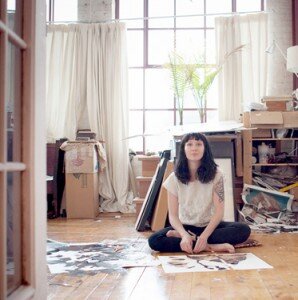Sienna Freeman
class of 2016
about
Born and raised in New York state, Sienna Freeman is a visual artist working with photographs, found images, and the dynamics of shadow and space. Utilizing the fragmented, layered, and surgical process of collage, she embraces methods that allow for an automatic processing of visual information; an intuitive sense of sight that is both linked to and detached from our present day mass media experience. Symbolic cultural imagery related to the body, birth, death, and “right of passage” rituals is often employed to discuss primal and universal fears, desires, and anxieties concerning the transitory nature of life and the contemporary human condition. Her work has exhibited across the United States and internationally in Switzerland, London, Belgium, and Canada.
Sienna completed a dual degree MA/MFA in Visual and Critical Studies and Fine Art at the California College of the Arts in 2016. Prior to joining the CCA community, she earned a BFA in Photography from the University of the Arts in Philadelphia, where she has since lectured and acted as a guest critic and juror. A former member of the Philadelphia based communal gallery Space1026, Sienna has also served as Gallery Administrator, Associate Director, and Director of Philadelphia’s Wexler Gallery. During her eight year tenure at Wexler Gallery she organized numerous exhibitions and curated four thematic invitationals, featuring works in a variety of mediums by artists from around the globe. During her time at CCA, she also worked as Gallery Manager of San Francisco’s Velvet da Vinci. Sienna currently serves as Program Manager for the Graduate Program in Visual and Critical Studies, VCS Dual-Degree Option, and Undergraduate Program in Visual Studies at the California College of the Arts.
sienna’s thesis
PULLED, STITCHED, AND STUFFED: MATERIALITY AND THE ABJECT IN DOROTHEA TANNING’S SOFT SCULPTURE
Dorothea Tanning’s soft sculptures created from 1965-1982 are largely absent from critical discourse, often overlooked or historicized as avatars for her painted figural elements. Although previous themes of bodies, boundaries, self-portraiture, and the female muse are present in Tanning’s soft sculptures, I argue that her cloth pieces draw new disruptive and transgressive power through the latent meanings associated with their textile-based materiality. They break the metaphorical picture plane associated with the imaginary, deviating from classic surrealist tropes, becoming experiential forms of corporeal matter that point to the abject. Tanning’s textile works elicit connections to the mortal bodily condition and functional objects with use value, pointing to material notions of “low” in terms of modernist hierarchies. By looking at Tanning’s soft sculpture through the lenses of the abject, craft theory, and material culture, I aim to suggest a revisionist understanding of one of Tanning’s most underappreciated bodies of work.


